Transfer Learning-Based Steering Angle Prediction and Control with Fuzzy Signatures-Enhanced Fuzzy Systems for Autonomous Vehicles
Abstract
:1. Introduction
2. Related Works
3. Methodology
3.1. Convolutional Neural Networks
3.2. Transfer Learning
3.3. Fuzzy Systems Control
3.4. Fuzzy Signatures
3.5. Data Preprocessing
3.6. Data Augmentation
3.7. Model Architecture
3.8. Algorithm
| Algorithm 1 Steering Angle Prediction and Control |
| Require: Input image sequences, Ensure: Controlled motor position, C
|
4. Modeling and Simulation
4.1. CNN Model Building with Transfer Learning
4.2. Motor Model
4.3. Fuzzy Signatures-Enhanced Fuzzy System Controller
4.4. Experimental Steps
5. Results
6. Conclusions
Author Contributions
Funding
Data Availability Statement
Conflicts of Interest
References
- Wolniak, R.; Stecuła, K. Artificial Intelligence in Smart Cities—Applications, Barriers, and Future Directions: A Review. Smart Cities 2024, 7, 1346–1389. [Google Scholar] [CrossRef]
- Bereczki, N.; Simon, V. Machine Learning Use-Cases in C-ITS Applications. Infocommunications J. 2023, XV, 26–43. [Google Scholar] [CrossRef]
- Shreyas, V.; Bharadwaj, S.N.; Srinidhi, S.; Ankith, K.U.; Rajendra, A.B. Self-driving cars: An overview of various autonomous driving systems. In Advances in Data and Information Sciences; Lecture Notes in Networks and Systems; Springer: Singapore, 2020; Volume 94, pp. 361–371. [Google Scholar] [CrossRef]
- Olivares-Mendez, M.A.; Sanchez-Lopez, J.L.; Jimenez, F.; Campoy, P.; Sajadi-Alamdari, S.A.; Voos, H. Vision-based steering control, speed assistance and localization for inner-cityvehicles. Sensors 2016, 16, 362. [Google Scholar] [CrossRef]
- Farkh, R.; Alhuwaimel, S.; Alzahrani, S.; Jaloud, K.A.; Quasim, M.T. Deep learning control for autonomous robot. Comput. Mater. Contin. 2022, 72, 2811–2824. [Google Scholar] [CrossRef]
- Mayne, A.J.; Klir, G.J.; Folger, T.A. Fuzzy Sets, Uncertainty, and Information. J. Oper. Res. Soc. 1990, 41, 884. [Google Scholar] [CrossRef]
- Ross, T. Fuzzy Logic with Engineering Applications, 3rd ed.; Wiley India Pvt. Ltd.: Bengaluru, India, 2011. [Google Scholar]
- Shukla, S.; Tiwari, M. Fuzzy Logic of Speed and Steering Control System for Three Dimensional Line Following of an Autonomous Vehicle. arXiv 2010, arXiv:1004.1675. [Google Scholar]
- Kóczy, L.T. Symmetry or Asymmetry? Complex Problems and Solutions by Computational Intelligence and Soft Computing. Symmetry 2022, 14, 1839. [Google Scholar] [CrossRef]
- Kóczy, L.; Zorat, A. Fuzzy systems and approximation. Fuzzy Sets Syst. 1997, 85, 203–222. [Google Scholar] [CrossRef]
- Saleem, H.; Riaz, F.; Mostarda, L.; Niazi, M.A.; Rafiq, A.; Saeed, S. Steering Angle Prediction Techniques for Autonomous Ground Vehicles: A Review. IEEE Access 2021, 9, 78567–78585. [Google Scholar] [CrossRef]
- Bojarski, M.; del Testa, D.W.; Dworakowski, D.; Firner, B.; Flepp, B.; Goyal, P.; Jackel, L.D.; Monfort, M.; Muller, U.; Zhang, J.; et al. End to End Learning for Self-Driving Cars. arXiv 2016, arXiv:1604.07316. [Google Scholar]
- Du, S.; Guo, H.; Simpson, A. Self-Driving Car Steering Angle Prediction Based on Image Recognition. arXiv 2019, arXiv:1912.05440. [Google Scholar]
- Faizi, F.S.; Alsulaifanie, A.K. Steering angle prediction via neural networks. Indones. J. Electr. Eng. Comput. Sci. 2023, 31, 392–399. [Google Scholar] [CrossRef]
- Le Cun, Y.; Jackel, L.; Boser, B.; Denker, J.; Graf, H.; Guyon, I.; Henderson, D.; Howard, R.; Hubbard, W. Handwritten digit recognition: Applications of neural network chips and automatic learning. IEEE Commun. Mag. 1989, 27, 41–46. [Google Scholar] [CrossRef]
- LeCun, Y.; Bengio, Y.; Hinton, G. Deep learning. Nature 2015, 521, 436–444. [Google Scholar] [CrossRef]
- Taherdoost, H. Deep Learning and Neural Networks: Decision-Making Implications. Symmetry 2023, 15, 1723. [Google Scholar] [CrossRef]
- Chen, J.; Chen, J.; Zhang, D.; Sun, Y.; Nanehkaran, Y. Using deep transfer learning for image-based plant disease identification. Comput. Electron. Agric. 2020, 173, 105393. [Google Scholar] [CrossRef]
- Iman, M.; Arabnia, H.R.; Rasheed, K. A Review of Deep Transfer Learning and Recent Advancements. Technologies 2023, 11, 40. [Google Scholar] [CrossRef]
- Sharma, S.; Jhaketiya, V.; Kaul, A.; Raza, A.A.; Ahmed, S.; Naseem, M. Automatic Prediction of Road Angles using Deep Learning-Based Transfer Learning Models. IOP Conf. Ser. Mater. Sci. Eng. 2021, 1099, 012060. [Google Scholar] [CrossRef]
- Muneeb ul Hassan. VGG16—Convolutional Network for Classification and Detection. 2018. Available online: https://neurohive.io/en/popular-networks/vgg16/ (accessed on 12 May 2024).
- Zadeh, L. Fuzzy sets. Inf. Control 1965, 8, 338–353. [Google Scholar] [CrossRef]
- Jantzen, J. Fuzzy Control. In Foundations of Fuzzy Control; John Wiley & Sons, Ltd.: Hoboken, NJ, USA, 2013; Chapter 3; pp. 55–84. [Google Scholar] [CrossRef]
- Karadeniz, A.M.; Alkayyali, M.; Péter Tamás, S. Modelling and Simulation of Stepper Motor For Position Control Using LabVIEW. Recent Innov. Mechatronics 2018, 5, 1–5. [Google Scholar] [CrossRef]
- Ahmet Mehmet, K.; Ammar, A.; Geza, H. Comparison between proportional, integral, derivative controller and fuzzy logic approaches on controlling quarter car suspension system. MATEC Web Conf. 2018, 184, 02018. [Google Scholar] [CrossRef]
- Pozna, C.; Minculete, N.; Precup, R.E.; Kóczy, L.T.; Ballagi, Á. Signatures: Definitions, operators and applications to fuzzy modelling. Fuzzy Sets Syst. 2012, 201, 86–104. [Google Scholar] [CrossRef]
- Kóczy, L.T.; Cornejo, M.E.; Medina, J. Algebraic structure of fuzzy signatures. Fuzzy Sets Syst. 2021, 418, 25–50. [Google Scholar] [CrossRef]
- Ballagi, Á.; Kóczy, L.T. Fuzzy signature based mobil robot motion control system. In Proceedings of the 2008 6th International Symposium on Applied Machine Intelligence and Informatics, Herlany, Slovakia, 21–22 January 2008; pp. 29–33. [Google Scholar]
- Moin, A. Udacity Self Driving Car—Behavioural Cloning. 2023. Available online: https://www.kaggle.com/code/shruti9821/self-driving-car-behavioural-cloning/input (accessed on 20 October 2023).
- Devnani, V.; Panjwani, C.; Kachhela, N.; Tewari, A.; Gwalani, N. Angle Detection of Steering in a Self-Driving Car. In Recent Trends in Materials; Springer: Singapore, 2022; Volume 18, pp. 453–462. [Google Scholar] [CrossRef]
- Jiang, Z.P.; Liu, Y.Y.; Shao, Z.E.; Huang, K.W. An improved VGG16 model for pneumonia image classification. Appl. Sci. 2021, 11, 11185. [Google Scholar] [CrossRef]
- Wang, C.; Cao, D. New Sensorless Speed Control of a Hybrid Stepper Motor Based on Fuzzy Sliding Mode Observer. Energies 2020, 13, 4939. [Google Scholar] [CrossRef]
- Godfrey, H. Fuzzy Logic with MATLAB; CreateSpace Independent Publishing Platform: North Charleston, SC, USA, 2016. [Google Scholar]
- Sivanandam, S.; Sumathi, S.; Deepa, S. Introduction to Fuzzy Logic Using MATLAB; Springer: Berlin/Heidelberg, Germany, 2006. [Google Scholar]
- Khristamto, M.; Praptijanto, A.; Kaleg, S. Measuring Geometric and Kinematic Properties to Design Steering Axis to Angle Turn of The Electric Golf Car. Energy Procedia 2015, 68, 463–470. [Google Scholar] [CrossRef]
- Anggono, A.D.; Sedyono, J.; Handaga, B. Geometric modeling and assembly analysis of 90 degree steering system. AIP Conf. Proc. 2018, 1977, 020063. [Google Scholar] [CrossRef]

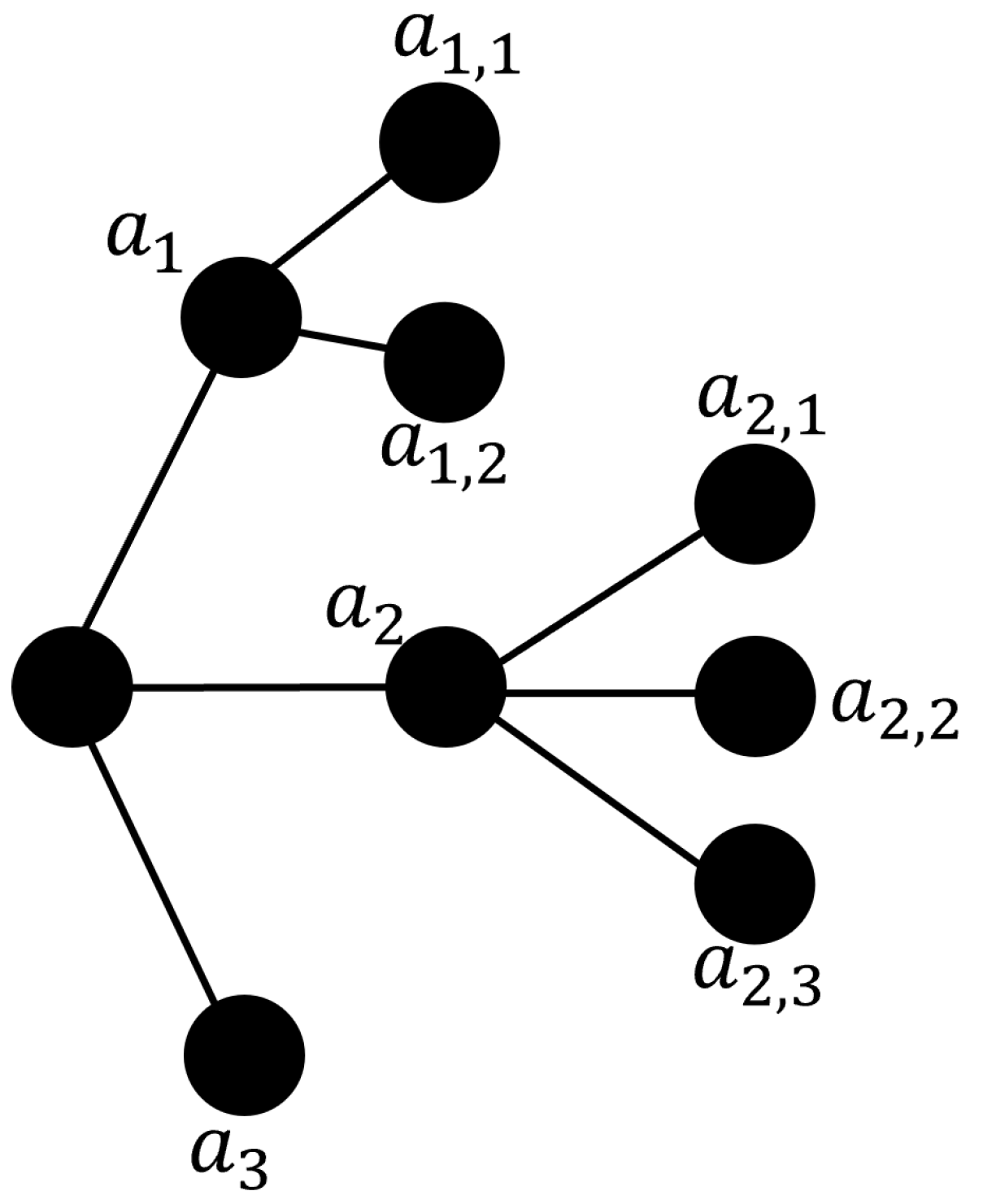


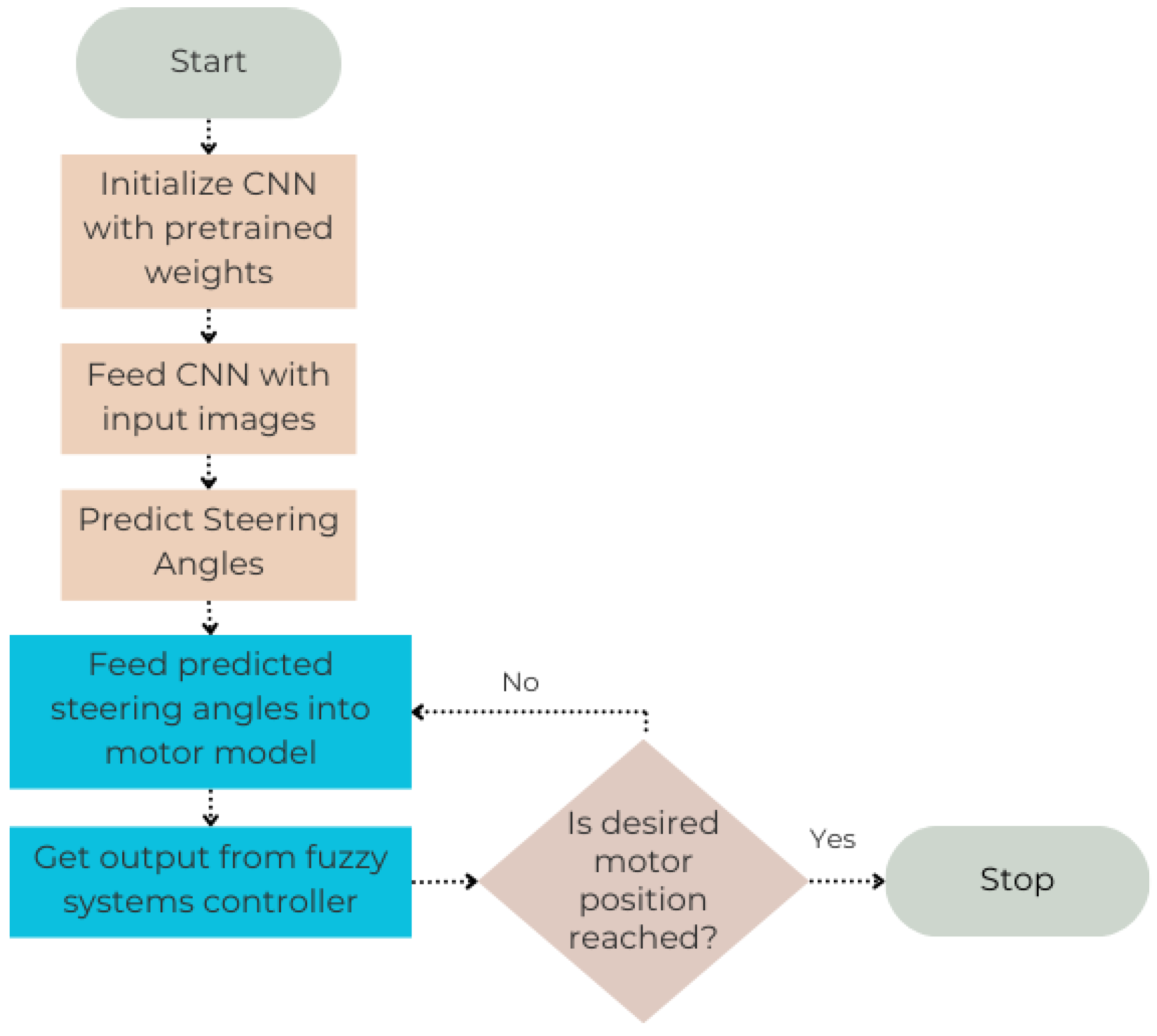


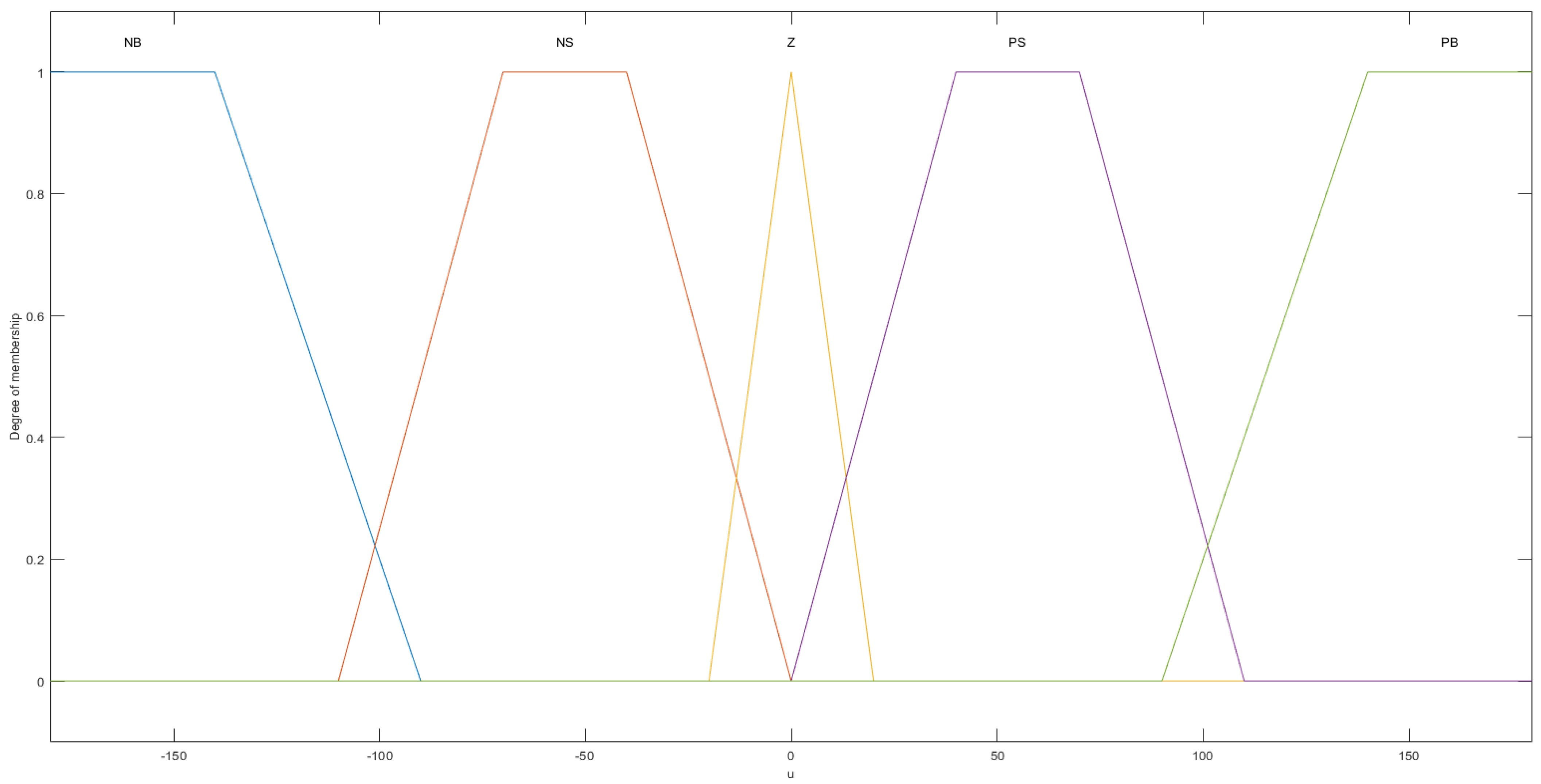

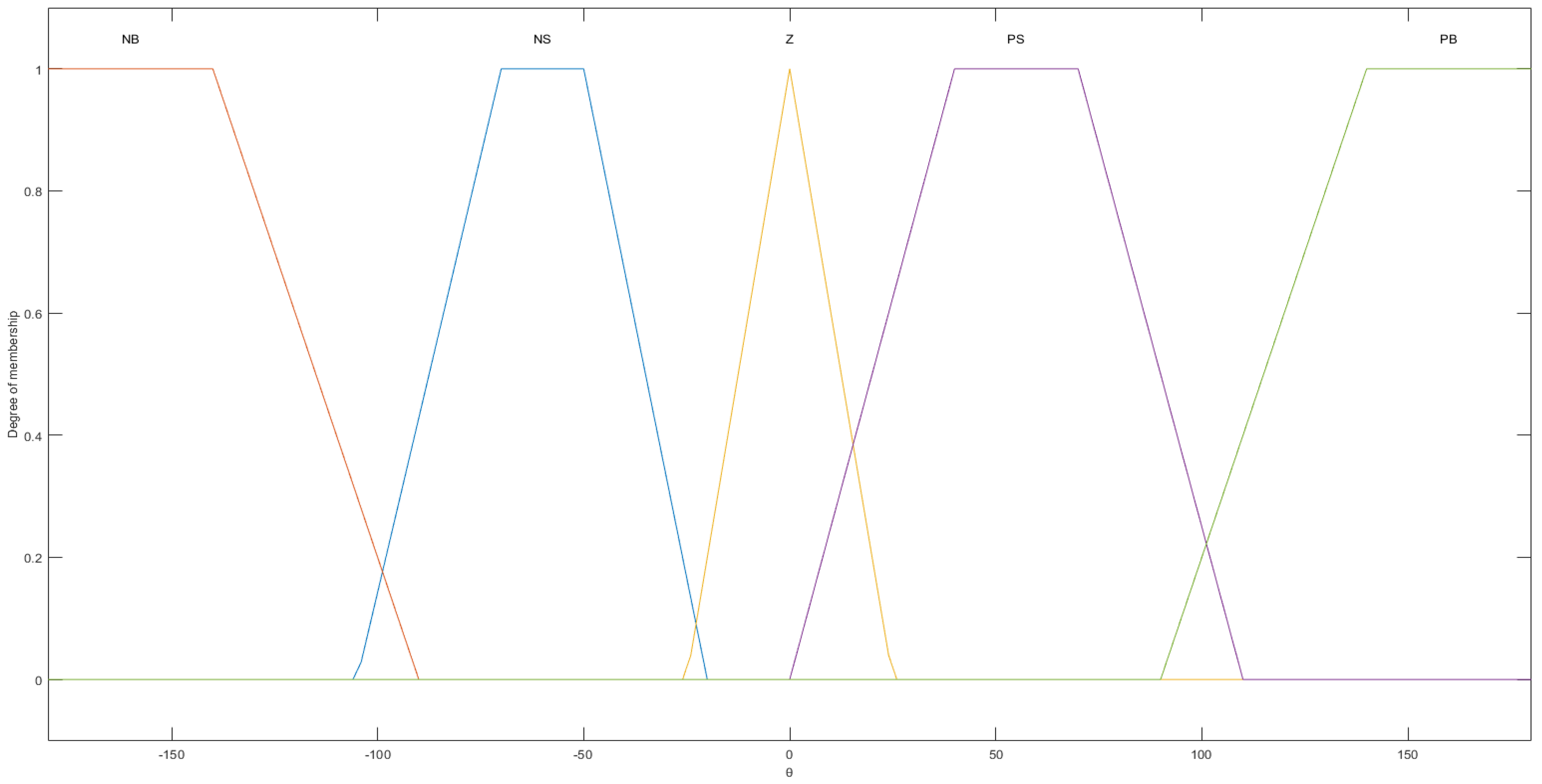
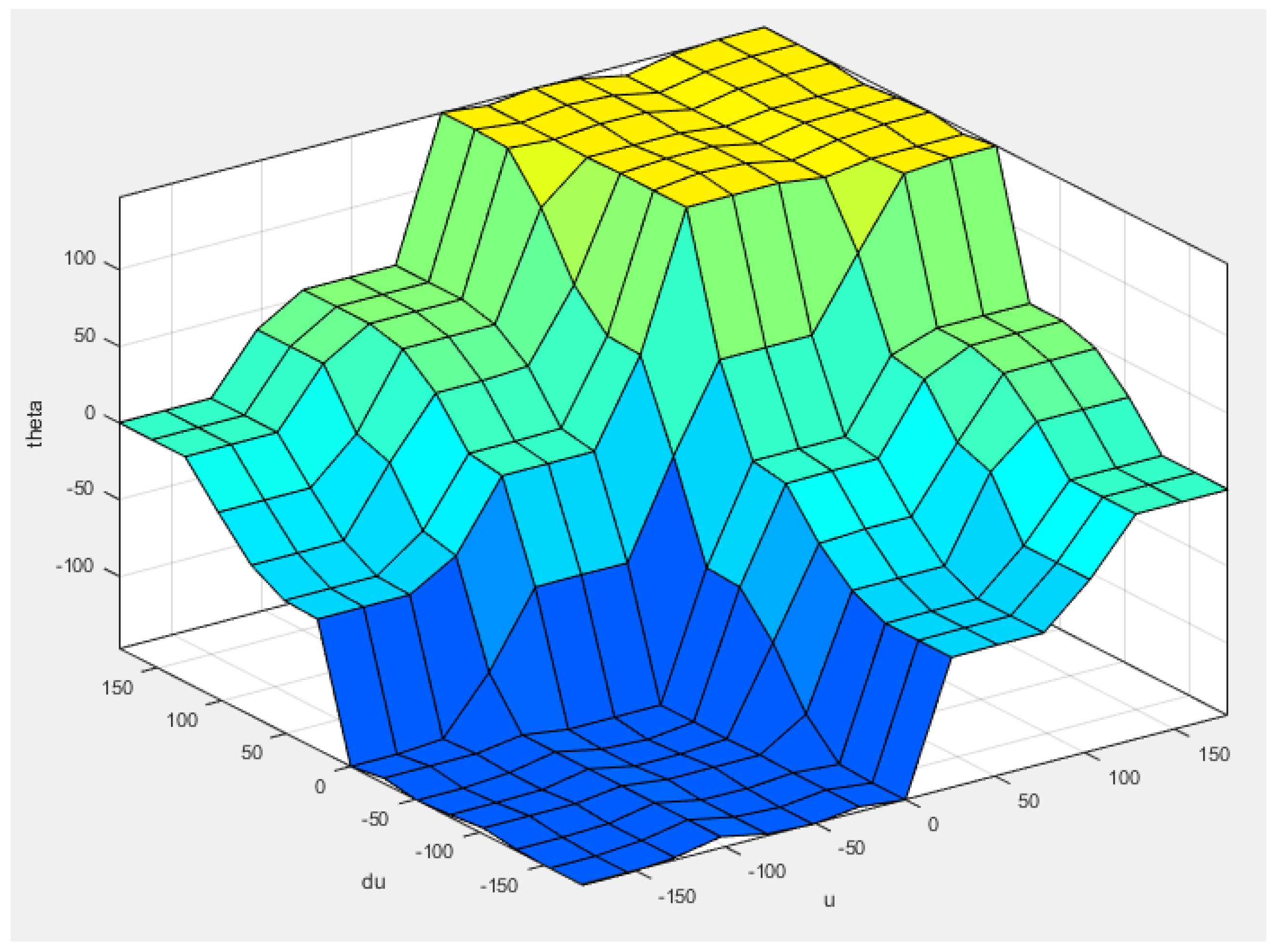
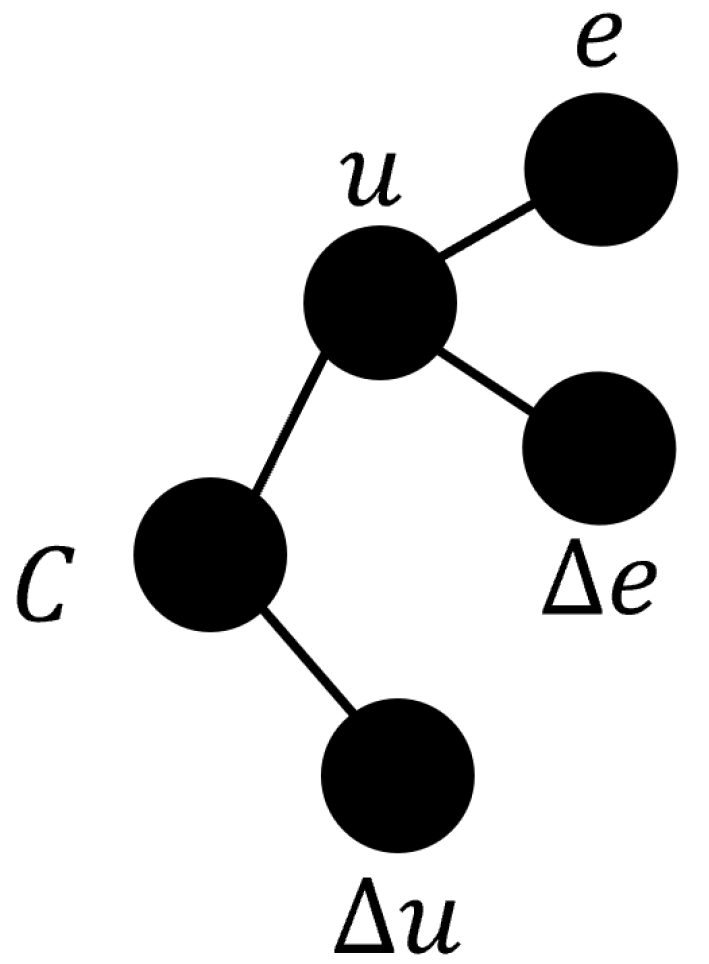
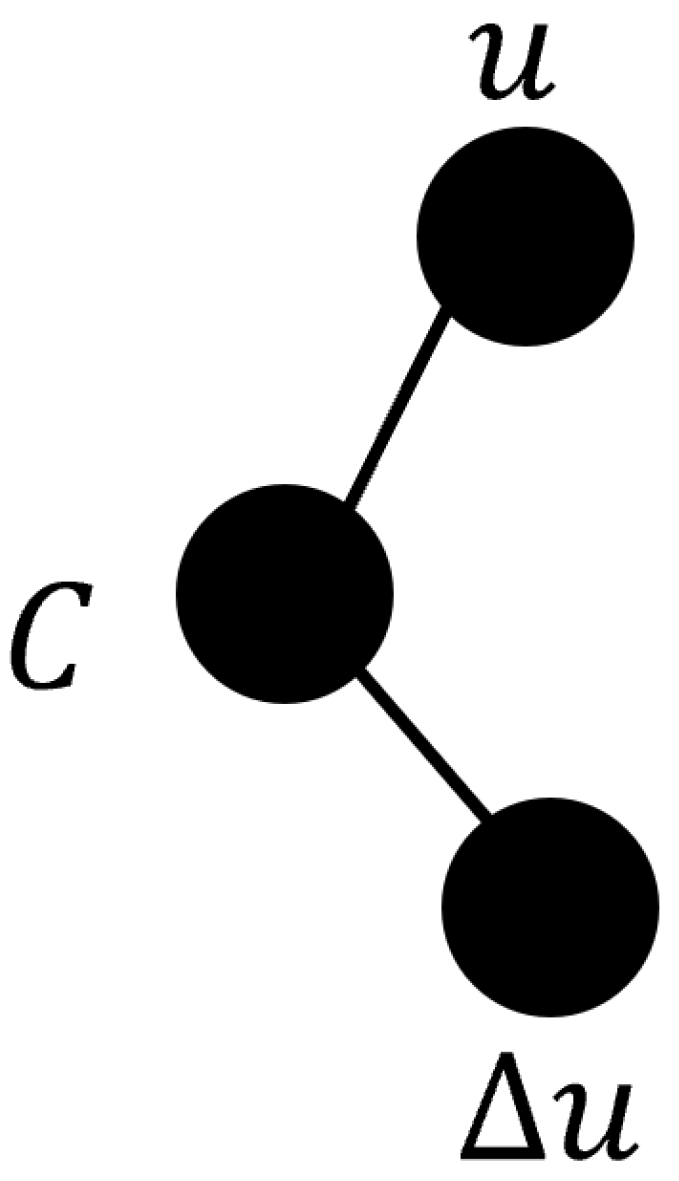
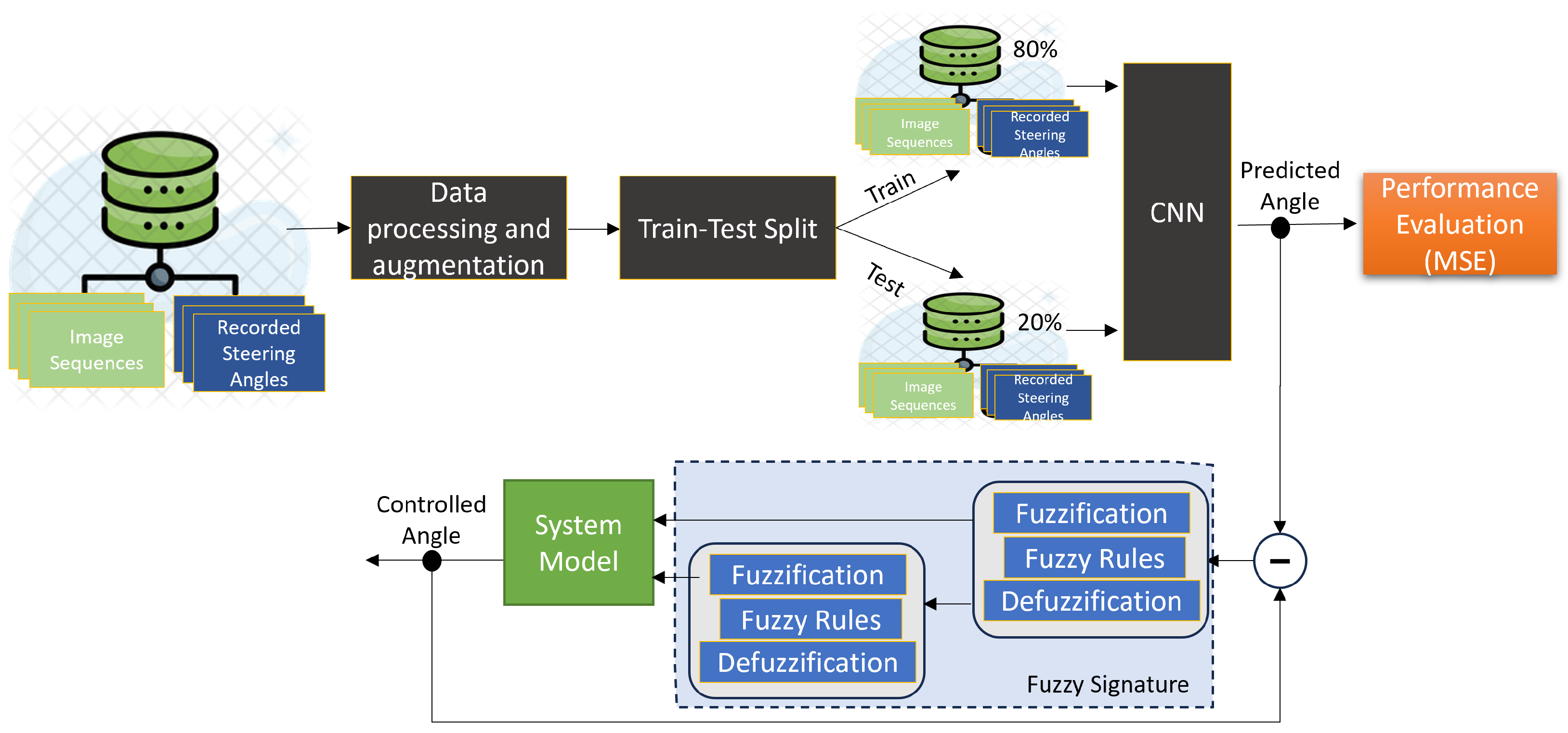
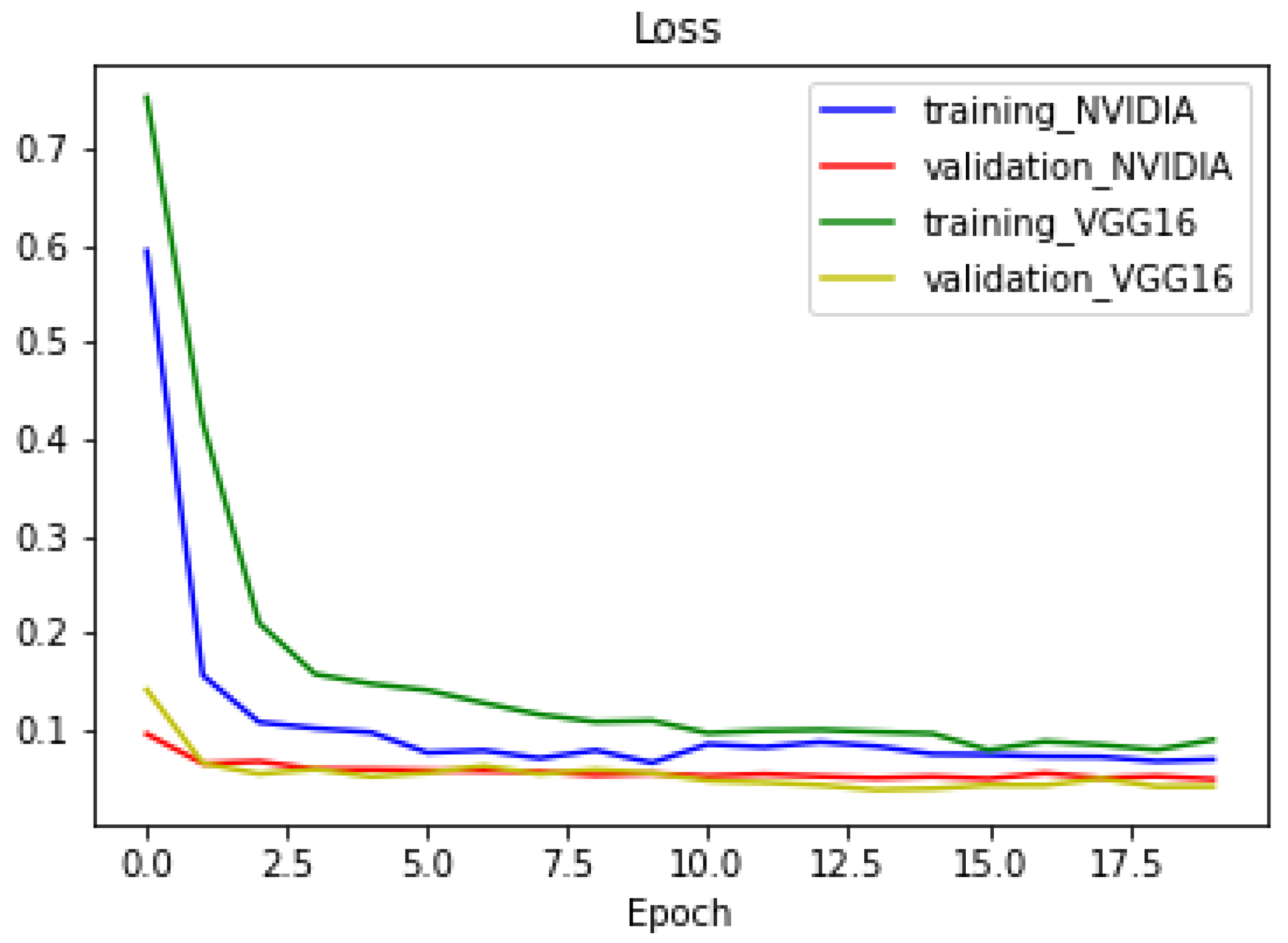
| Parameter (unit) | Value |
|---|---|
| J (kg·m2) | 0.08 |
| B (kg/s·m) | 3 |
| R (ohm) | 6 |
| L (mH) | 3 |
| k | 3 |
| p | 4 |
| u/u | NB | NS | Z | PS | PB |
|---|---|---|---|---|---|
| NB | NB | NB | NB | NS | Z |
| NS | NB | NB | NS | Z | PS |
| Z | NB | NS | Z | PS | PB |
| PS | NS | Z | PS | PB | PB |
| PB | Z | PS | PB | PB | PB |
| Model | Mean Squared Error (MSE) | Mean Absolute Error (MAE) |
|---|---|---|
| NVIDIA | 0.0486 | 0.1622 |
| Proposed Model | 0.0376 | 0.1454 |
| Benefit | 22.63% | 10.35% |
| Model | Performance Change (%) |
|---|---|
| 3D LSTM [13] | −13.89 |
| ResNet50 Transfer Learning [13] | 22.11 |
| ANN [14] | 10.87 |
| Proposed Model | 22.63 |
| Actual Value | Predicted Value | Output Value |
|---|---|---|
| 5.04° | 6.15° | 6.01° |
| 15.03° | 13.88° | 13.73° |
| 29.75° | 28.15° | 28.71° |
| 45.0° | 42.05° | 42.24° |
| 54.0° | 50.80° | 50.62° |
| −15.13° | −14.80° | −14.50° |
| −20.27° | −21.16° | −19.89° |
| −27.0° | −28.08° | −28.27° |
| −45.0° | −42.38° | −42.53° |
Disclaimer/Publisher’s Note: The statements, opinions and data contained in all publications are solely those of the individual author(s) and contributor(s) and not of MDPI and/or the editor(s). MDPI and/or the editor(s) disclaim responsibility for any injury to people or property resulting from any ideas, methods, instructions or products referred to in the content. |
© 2024 by the authors. Licensee MDPI, Basel, Switzerland. This article is an open access article distributed under the terms and conditions of the Creative Commons Attribution (CC BY) license (https://creativecommons.org/licenses/by/4.0/).
Share and Cite
Karadeniz, A.M.; Ballagi, Á.; Kóczy, L.T. Transfer Learning-Based Steering Angle Prediction and Control with Fuzzy Signatures-Enhanced Fuzzy Systems for Autonomous Vehicles. Symmetry 2024, 16, 1180. https://doi.org/10.3390/sym16091180
Karadeniz AM, Ballagi Á, Kóczy LT. Transfer Learning-Based Steering Angle Prediction and Control with Fuzzy Signatures-Enhanced Fuzzy Systems for Autonomous Vehicles. Symmetry. 2024; 16(9):1180. https://doi.org/10.3390/sym16091180
Chicago/Turabian StyleKaradeniz, Ahmet Mehmet, Áron Ballagi, and László T. Kóczy. 2024. "Transfer Learning-Based Steering Angle Prediction and Control with Fuzzy Signatures-Enhanced Fuzzy Systems for Autonomous Vehicles" Symmetry 16, no. 9: 1180. https://doi.org/10.3390/sym16091180






